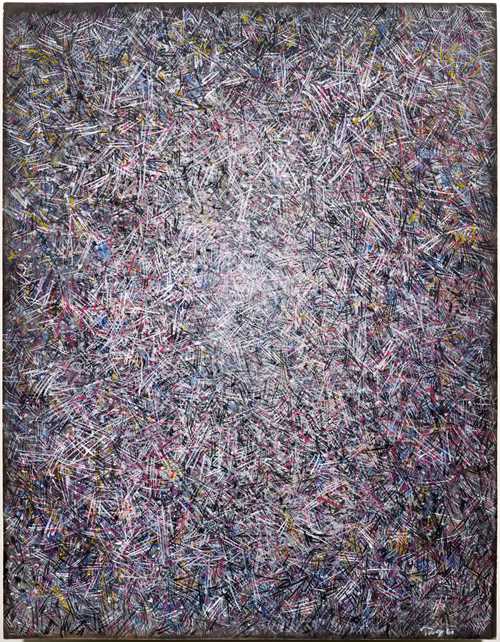
Lot 3710 - A193 PostWar & Contemporary - samedi, 04. juillet 2020, 14h00
MARK TOBEY
Provenance:
- Purchased directly from the artist by the previous owner, private collection Switzerland.
- Private collection Switzerland.
“The dimension that counts for the creative person is the space he creates within himself. This inner space is closer to the infinite than the other, and it is the privilege of the balanced mind. And the search for an equilibrium is essential - to be as aware of inner space as he is of outer space.”
Mark Tobey’s pictorial world is complex and characterised by an almost inexhaustible potential for creativity, love of experimentation and power to innovate. His works are an expression of his spirituality and his perception of the world. The impressive materiality and stylistic diversity of his works reveal and make possible a broad range of themes, such as nature, civilization, cities, movements, the heavens and the cosmos, rhythm and music, emptiness, and contemplation. He is inspired by his surroundings, where he tries to see an abstraction in which a profound, rhythmic plasticity is concealed.
Born in 1890, Mark Tobey grew up in the American Mid-West and on the shores of the Mississippi in Wisconsin. At the age of 16 he moved to Chicago where he attended courses in oil and watercolour painting at the Art Institute and earned money as an industrial designer in a steel mill. In 1911 he went to New York, where he worked as a portrait painter and fashion illustrator for Vogue magazine. During his time in New York Mark Tobey discovered and became a follower of the spiritual teachings of Bahā'ullāh, who strove to create a union of the multifarious great world religions and hence a shared wisdom. It was not until his move to Seattle in 1922 that he began to shift towards avant-garde art. He taught at the Seattle Cornish College of the Arts and at the same time became fully immersed in Chinese painting. From 1925 he began to travel, and stayed in Paris and the Near East, and then made a longer journey to China and Japan, where, at a Zen monastery, he became involved in the Zen teachings and painting as well as with calligraphy. From then onwards he sought to combine the linear flow inspired by the Far East, with the European concept of mass and volume, and to create a balance between the outlook of these two worlds. At the same time, he maintained a foothold in England, where he taught at the Dartington Hall School in Devonshire between 1930 and 1938. In 1960 Tobey settled in Basel. In the same year, the husband and wife collectors Ernst and Hildy Beyeler acquired 40 works from the artist.
Mark Tobey made every country where he stayed for a while into his homeland and was one of the few cosmopolitan artists of the 20th century. He lived between cultures and worlds, and that is the aura which his works exude.
Through his many years of involvement with calligraphy, Mark Tobey developed his own pictorial script; in doing so he never had the intention of imitating East Asian pictorial language, but rather of finding his own representation with his western influences. In addition, the city of New York played an eminently important role in the development of his personal approach to abstraction. Reflecting on the architecture of Manhattan, as well as the influence of calligraphy and his accumulated spiritual experiences, he formed his personal style of "White Writing". “For a long time, I tried to connect cities and city life in my work. In the end I felt that I had found a technical approach, which allowed me to capture what I was interested in. Lights, the threads of traffic, the river of humanity, erect and flowing through and around self-imposed borders, not unlike chlorophyll as it flows through the channels of a leaf. “ (From: Anna Moszynska, Abstract Art, London 1990, p. 133).
The first two works from 1959 and 1960 (Lots XXX and XXX) offered here at auction, were produced during the period when he was emigrating from the US to Switzerland and are wonderful examples of his "White Writing". What is striking about the works from this period are firstly their small, indeed intimate format. Tobey devotes himself meticulously and with great perseverance to the creation of microscopic worlds, which he has drawn from his observation of nature, the city, and the light. The strokes become increasingly overgrown, bound together, overlaid, depicting labyrinths, urban structures, fields, fungi, or organic structures. "White lines in movement symbolize a unifying idea which flows through the compartmented units of life bringing the consciousness of a larger relativity."
In the three later works presented here (Lots XXX, XXX and XXX/1968, 1964 and 1969) we also find an organic structure, yet Mark Tobey has abandoned the meticulous fine, stroke-like drawing style, in order to find expression through larger strokes and a colourful palette. The wonderful work from 1969 has an arrestingly generous format, strong colours, and energetic movement in the brush strokes.
Although all these works were produced at different times, they give the impression of all having been created from a meditative state. Tobey says in respect to this: "I believe that painting should come through the avenues of meditation rather than the canals of action."
His abstract expressionist works, with their fine, spot- or thread-like dense style appear animated and yet they radiate an unshakeable sense of harmony. The resulting mesh of lines are overlaid in countless layers, always consistent, and always interconnected.
CHF 60 000 / 80 000 | (€ 61 860 / 82 470)
Vendu pour CHF 132 060 (frais inclus)
Aucune responsabilité n'est prise quant à l´exactitude de ces informations.

